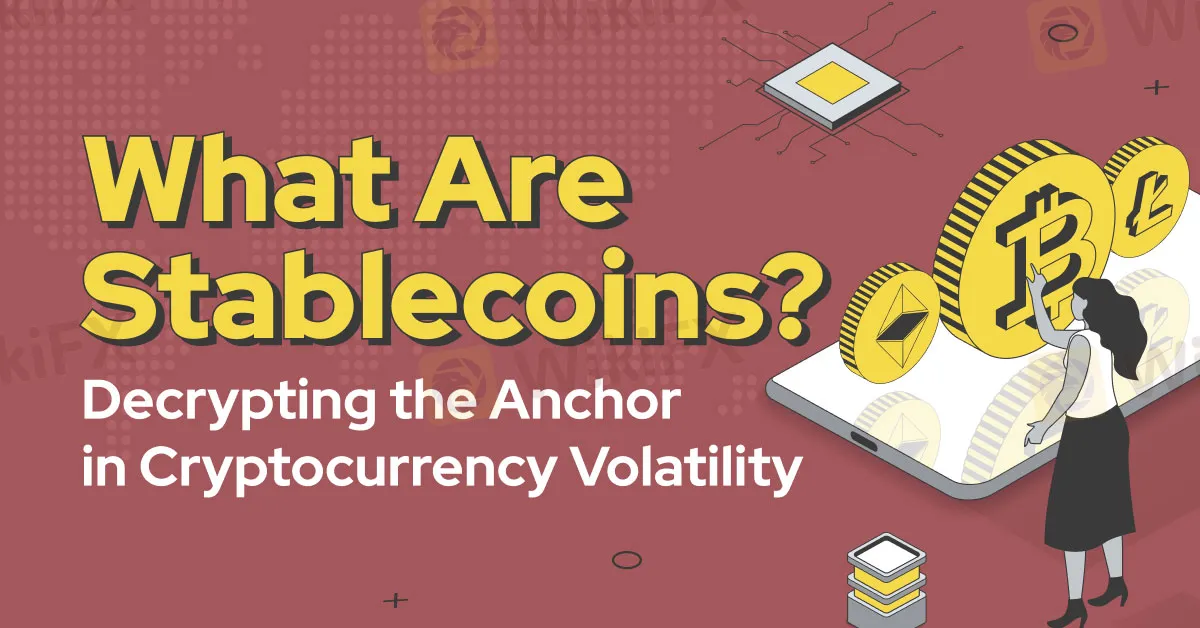简体中文
繁體中文
English
Pусский
日本語
ภาษาไทย
Tiếng Việt
Bahasa Indonesia
Español
हिन्दी
Filippiiniläinen
Français
Deutsch
Português
Türkçe
한국어
العربية
What Are Stablecoins? Decrypting the Anchor in Cryptocurrency Volatility
Abstract:What are stablecoins? Why do we need stablecoins? This article will explain it all!

In the dynamic world of cryptocurrencies, where values can soar to extraordinary heights or plunge unexpectedly, the concept of stability seems like an elusive dream. However, within this volatile landscape, a category of digital assets known as stablecoins has emerged, providing a reliable anchor amidst the market turbulence.
At its core, a stablecoin is a type of cryptocurrency designed to maintain a stable value by pegging it to another asset, typically a fiat currency like the US dollar. This pegging is achieved through various mechanisms, ensuring that the value of the stablecoin remains steady, mirroring the price of the chosen underlying asset.
Why the need for stablecoins, you might wonder? Well, the inherent volatility of traditional cryptocurrencies like Bitcoin and Ethereum has presented challenges for broader adoption and everyday use. Imagine purchasing a cup of coffee with a cryptocurrency that might significantly increase or decrease in value within minutes—this unpredictability impedes its practicality as a medium of exchange.
Stablecoins address this issue by offering stability, acting as a bridge between the crypto realm and the stability of fiat currencies. They allow users to retain the advantages of blockchain technology—such as fast and borderless transactions—while minimizing exposure to price fluctuations.

There are different types of stablecoins, broadly categorized into three main groups based on their underlying mechanisms:
Fiat-Collateralized Stablecoins: These are backed by fiat currencies, maintaining a 1:1 ratio. For instance, for every unit of a fiat-collateralized stablecoin issued, theres an equivalent amount of fiat currency held in reserve. Tether (USDT), USD Coin (USDC), and TrueUSD (TUSD) are prominent examples in this category.
Crypto-Collateralized Stablecoins: These stablecoins are backed by other cryptocurrencies held as collateral. The value is maintained by over-collateralizing the assets, ensuring that the value of the collateral remains higher than the stablecoin issued. Dai, governed by MakerDAO, is a leading example in this domain.
Algorithmic Stablecoins: This type employs smart contracts and algorithms to manage the stablecoins supply in response to market demand, without direct collateral backing. The aim is to stabilize the price through various mechanisms like expanding or contracting the supply. Basis and Terra are among the notable projects exploring this approach.
The adoption of stablecoins has surged across various sectors within the crypto space. They serve as a reliable medium for traders to hedge against market volatility, allowing them to swiftly move funds in and out of volatile cryptocurrencies. Moreover, stablecoins facilitate faster and cheaper cross-border transactions compared to traditional banking systems, making them an attractive choice for remittances and international transfers.
Regulatory bodies worldwide have also taken a keen interest in stablecoins due to their potential impact on the financial system. Concerns regarding transparency, reserve backing, and compliance with existing regulations have prompted discussions and calls for oversight in the issuance and usage of stablecoins.
In conclusion, stablecoins represent a crucial innovation within the cryptocurrency sphere, offering stability in an otherwise unpredictable landscape. Their versatility and potential to revolutionize payment systems have garnered attention from both individuals and institutions, paving the way for a more seamless integration of cryptocurrencies into everyday financial transactions. As the crypto market continues to evolve, stablecoins are poised to play an increasingly integral role in shaping its future.

Disclaimer:
The views in this article only represent the author's personal views, and do not constitute investment advice on this platform. This platform does not guarantee the accuracy, completeness and timeliness of the information in the article, and will not be liable for any loss caused by the use of or reliance on the information in the article.
Read more

Coinbase Under Scrutiny Amid Wrapped Bitcoin Delisting Controversy
Coinbase has come under fire after announcing its decision to delist Wrapped Bitcoin (wBTC), a move critics claim could be driven by competitive interests. The delisting, set to take effect on 19 December, has sparked allegations of market manipulation and concerns about fairness in the cryptocurrency ecosystem.

Solana Soars to All-Time High, Hits $264 on Coinbase
Solana hits $264 on Coinbase, breaking its 3-year high with an 11% daily surge. Learn what’s driving SOL's meteoric rise and the crypto market rally.

Bitcoin Nears $100,000: A Triumph of Optimism or a Warning Sign?
Bitcoin’s meteoric rise continues to capture global attention as its price recently surpassed the $99,000 mark, briefly approaching the $100,000 milestone. This unprecedented rally has led market sentiment to reach a state of “extreme greed,” according to the Fear and Greed Index. Analysts suggest that the market may be entering overheated territory, raising questions about sustainability amidst ongoing enthusiasm.

FCA Alerts Traders to New List of Unregulated and Clone Brokers
Protect your investments! Learn about unregulated firms flagged by the FCA and discover how WikiFX helps traders avoid scams and choose legitimate brokers.
WikiFX Broker
Latest News
Webull Partners with Coinbase to Offer Crypto Futures
eToro Expands Nationwide Access with New York Launch
GCash, Government to Launch GBonds for Easy Investments
Why Is UK Inflation Rising Again Despite Recent Lows?
Hackers Charged for $11M Crypto Theft Using SIM-Swaps
Role of Central Banks in the FX Market
FCA Alerts Against Sydney FX
Interactive Brokers Launches Tax-Friendly PEA Accounts in France
Former Director Sentenced for Share Disclosure Breach
PayPal Expands PYUSD Use for Seamless Cross-Border Transfers
Currency Calculator


